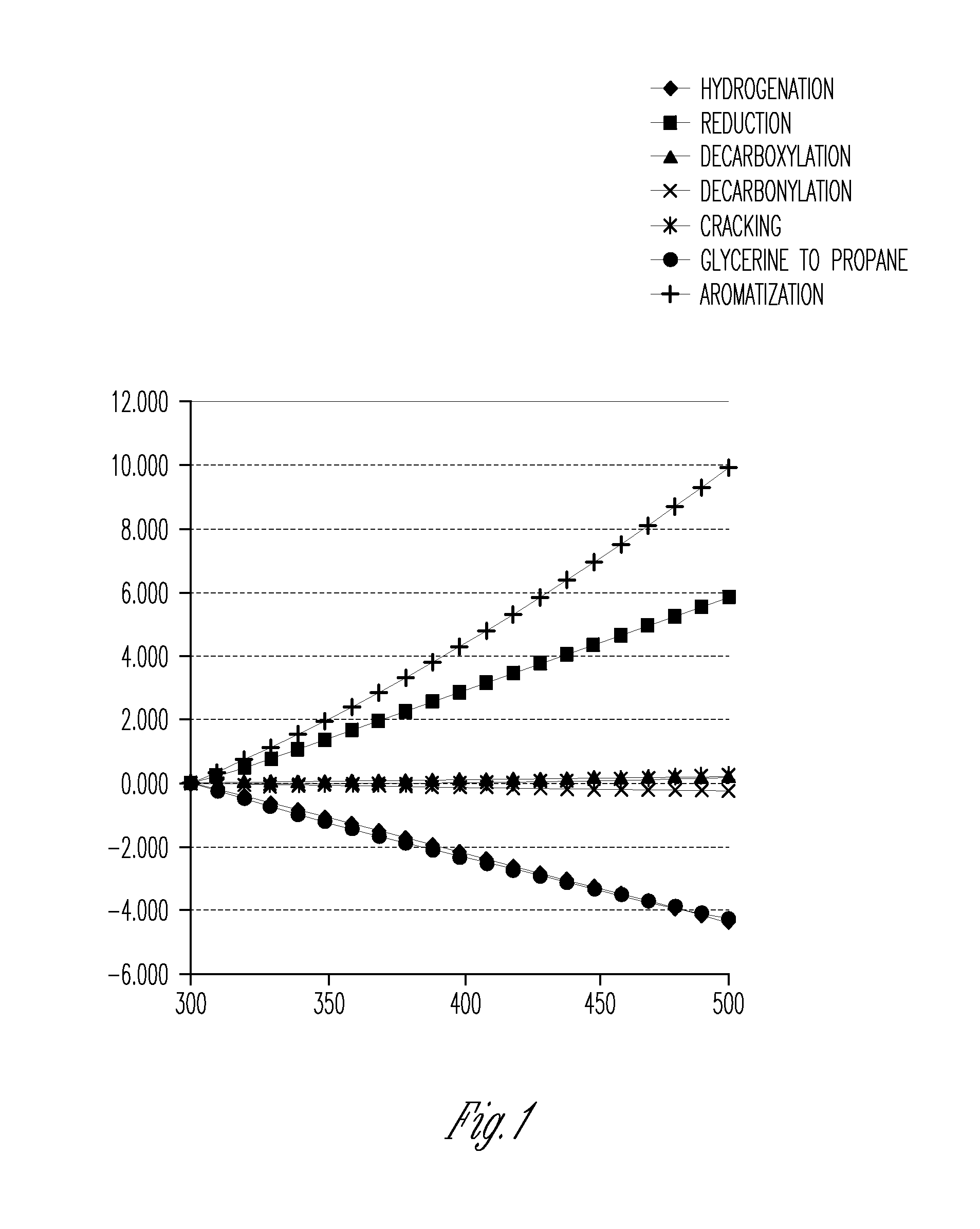Process for the conversion of renewable oils to liquid transportation fuels
a technology of renewable oil and liquid transportation fuel, which is applied in the direction of hydrocarbon oil treatment products, fuels, biofuels, etc., can solve the problems of increasing the cost of petroleum-derived fuels, increasing the acidity of products, and suffering serious physical limitations when used as sole fuels, etc., to achieve the effect of high rate of one reaction, and increasing the temperature of the reaction mixtur
- Summary
- Abstract
- Description
- Claims
- Application Information
AI Technical Summary
Benefits of technology
Problems solved by technology
Method used
Image
Examples
examples 1-9
[0078]The apparatus of Examples 1-9 was a continuous-flow reactor including a pump system, gas flow system, high-pressure reactor vessel, reactor heater and temperature regulation device, product collection receptacle, and pressure regulation device. Appropriate instrumentation and electronics were attached to the device to enable control and recording of experimental conditions. Samples of product were removed through the sample receptacle and analyzed with appropriate analytical instrumentation (e.g., gas chromatography-mass spectrometry, GC-MS). Hydrogen was supplied to the reactor system from purchased cylinders. Feedstock material was supplied to the reactor system via a high-pressure pumping system. In Examples 1-9, 1.12 kg of a nonsulfided nickel-molybdenum hydrotreating catalyst (Criterion CR-424) was charged to the reactor chamber. The chamber possessed a length-to-diameter ratio of 6. The catalyst was activated by warming to greater than 300° C. while a flow of ...
example 1
[0079]Coconut oil was supplied to the reactor at a rate of about 1 pound / hour. Hydrogen was supplied at a rate of about 20 standard cubic feet per hour (scfh). The reactor was maintained at about 340° C. The hydrogen pressure was regulated to about 80 psi. The temperature and flow conditions were maintained for about 3 hours once steady-state conditions were achieved. The product was collected and analyzed. Results are shown in Table 2.
TABLE 2Results from First Test MatrixSaturatedOlefinicFattyOil Flow,Temp.,Pressure,H2 Flow,Hydrocarbons,Hydrocarbons,Acids,Examplelb / hr° C.psigscfh%%%11340802043.827.419.0213501002027.233.926.9323501004021.826.140.0413502002050.418.016.0523502004027.320.041.9614001002040.637.07.4724001004037.732.316.9814002002073.510.53.2924002005063.313.82.2
example 2
[0080]Coconut oil was supplied to the reactor at a rate of about 1 pound / hour. Hydrogen was supplied at a rate of about 20 scfh. The reactor was maintained at about 350° C. The hydrogen pressure was regulated to about 100 psi. The temperature and flow conditions were maintained for about 3 hours once steady-state conditions were achieved. The product was collected and analyzed. Results are shown in Table 2.
PUM
| Property | Measurement | Unit |
|---|---|---|
| pressure | aaaaa | aaaaa |
| temperature | aaaaa | aaaaa |
| pressure | aaaaa | aaaaa |
Abstract
Description
Claims
Application Information
 Login to View More
Login to View More - R&D
- Intellectual Property
- Life Sciences
- Materials
- Tech Scout
- Unparalleled Data Quality
- Higher Quality Content
- 60% Fewer Hallucinations
Browse by: Latest US Patents, China's latest patents, Technical Efficacy Thesaurus, Application Domain, Technology Topic, Popular Technical Reports.
© 2025 PatSnap. All rights reserved.Legal|Privacy policy|Modern Slavery Act Transparency Statement|Sitemap|About US| Contact US: help@patsnap.com


